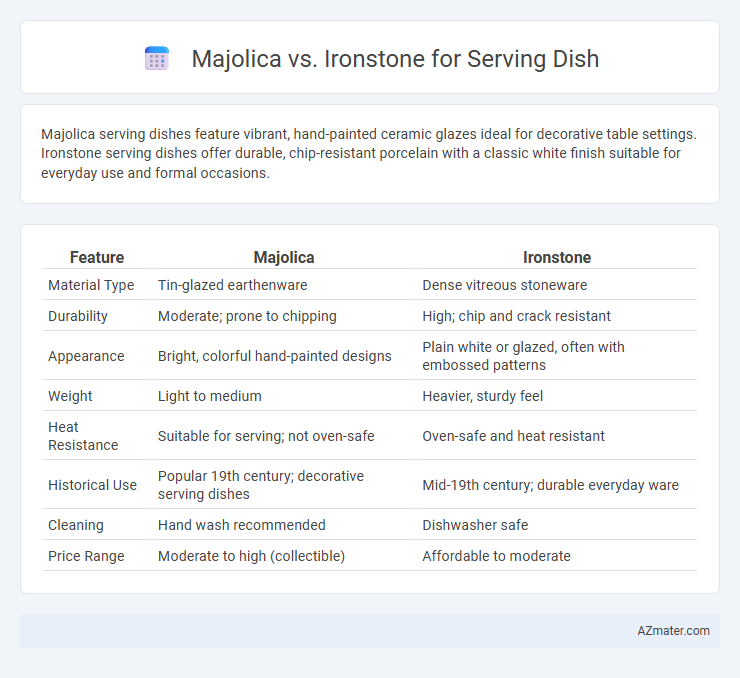Majolica serving dishes feature vibrant, hand-painted ceramic glazes ideal for decorative table settings. Ironstone serving dishes offer durable, chip-resistant porcelain with a classic white finish suitable for everyday use and formal occasions.
Table of Comparison
| Feature | Majolica | Ironstone |
|---|---|---|
| Material Type | Tin-glazed earthenware | Dense vitreous stoneware |
| Durability | Moderate; prone to chipping | High; chip and crack resistant |
| Appearance | Bright, colorful hand-painted designs | Plain white or glazed, often with embossed patterns |
| Weight | Light to medium | Heavier, sturdy feel |
| Heat Resistance | Suitable for serving; not oven-safe | Oven-safe and heat resistant |
| Historical Use | Popular 19th century; decorative serving dishes | Mid-19th century; durable everyday ware |
| Cleaning | Hand wash recommended | Dishwasher safe |
| Price Range | Moderate to high (collectible) | Affordable to moderate |
Introduction to Majolica and Ironstone
Majolica is a vibrant, tin-glazed pottery known for its intricate hand-painted designs and bright colors, originating from 19th-century Europe, particularly Italy and England. Ironstone, developed in early 19th-century England, is a durable, stoneware-like ceramic made from refined clay with a heavy, robust feel and typically features simple, classic white or cream finishes. Both materials serve distinct aesthetic and functional purposes in serving dishes, with majolica prized for decorative appeal and ironstone valued for its strength and everyday usability.
Historical Background of Majolica
Majolica, originating in the Renaissance period, is renowned for its brightly colored tin-glazed pottery that uses vibrant pigments on a white, opaque surface, a technique first developed in Italy during the 15th century. This ceramic art form gained widespread popularity during the Victorian era, especially in England, known for its intricate, nature-inspired designs that contrast with the more utilitarian, heavier Ironstone dishes introduced in the early 19th century. Collectors and culinary enthusiasts often prefer Majolica serving dishes for their decorative appeal and historical craftsmanship, reflecting a rich cultural heritage distinct from the durable and plain aesthetic of Ironstone.
Origins and Evolution of Ironstone
Ironstone originated in early 19th-century England as a durable, affordable alternative to fine porcelain, characterized by its dense, vitreous body and resistance to chipping. Unlike Majolica, which features vibrant, lead-glazed earthenware with colorful, often whimsical designs, Ironstone evolved to prioritize practicality and mass production, becoming a staple in Victorian-era homes and restaurants. Its development was driven by industrial innovation, making it a popular choice for heavy-duty serving dishes that combine utilitarian function with classic, understated aesthetics.
Key Material Differences Explained
Majolica serving dishes are crafted from earthenware clay with a tin-glazed surface, providing vibrant colors and a glossy finish ideal for decorative and lightweight use. Ironstone, made from dense vitrified stoneware, offers exceptional durability, chip resistance, and a heavier feel, making it suitable for everyday functional serving. The key material difference lies in Majolica's porous clay base requiring glazing for stain resistance, while Ironstone's dense composition naturally resists moisture and heat, enhancing longevity in kitchen use.
Distinctive Appearance and Color Variations
Majolica serving dishes feature vibrant, hand-painted glazes with intricate patterns and a distinctive glossy, translucent finish that highlights their rich color variations from bright turquoise to deep greens and reds. Ironstone serving dishes exhibit a more robust, opaque white or cream appearance with subtle glaze variations, often decorated with transfer prints or simple embossing for a classic, understated look. The striking visual contrast between Majolica's vivid, artistic hues and Ironstone's solid, utilitarian palette makes each ideal for different table settings and culinary presentations.
Durability and Everyday Use
Majolica serving dishes, known for their vibrant, glazed earthenware, offer decorative appeal but are more prone to chipping and cracking with heavy everyday use compared to ironstone. Ironstone, crafted from dense, vitrified stoneware, provides superior durability and resistance to scratches, making it ideal for frequent handling and dishwasher use. Choosing ironstone ensures longevity and practical performance for daily serving needs without compromising on classic style.
Maintenance and Cleaning Considerations
Majolica serving dishes require gentle hand washing with mild detergent to preserve their vibrant, glazed surface and prevent cracking or fading. Ironstone is more durable and dishwasher-safe, making it easier to clean and maintain for everyday use. Both materials benefit from avoiding abrasive scrubbers and sudden temperature changes to extend their lifespan.
Aesthetic Appeal for Table Settings
Majolica serving dishes feature vibrant, hand-painted glazes with intricate patterns that add a colorful, artistic flair to table settings, making them ideal for creating a lively and elegant presentation. Ironstone serving dishes offer a timeless, sturdy appeal with their smooth, white or cream surfaces and subtle embossed designs, providing a classic and refined backdrop for any meal. Both materials enhance table aesthetics uniquely: Majolica with bold visual interest and Ironstone with understated sophistication.
Collectibility and Market Value
Majolica serving dishes are prized for their vibrant, hand-painted glazes and unique Victorian-era designs, making them highly collectible among antique enthusiasts and commanding strong market value, particularly rare or well-preserved pieces. Ironstone, known for its durability and classic white or blue transferware patterns, appeals to collectors favoring practicality and historic English pottery, often maintaining stable value with certain brand marks like Mason or Johnson Brothers increasing desirability. Both materials hold distinct niches in the antique market, with Majolica favored for decorative appeal and Ironstone for functional elegance, influencing their respective collectibility and price trends.
Choosing the Right Serving Dish for Your Needs
Majolica serving dishes offer vibrant colors and intricate designs ideal for decorative presentations, while ironstone provides durable, chip-resistant surfaces perfect for everyday use. Consider choosing Majolica if you prioritize aesthetic appeal and occasional serving during special occasions, whereas ironstone suits those seeking long-lasting functionality and effortless maintenance. Matching your dish choice to your serving environment ensures optimal performance and style tailored to your needs.

Infographic: Majolica vs Ironstone for Serving Dish
 azmater.com
azmater.com